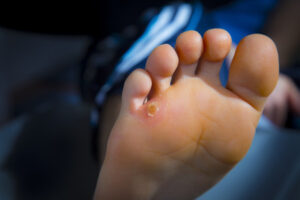
WHAT ARE CORNS AND CALLUSES ?
A corn is skin that has become hard and thick and can occur on the top, between, or on the tip of the toes. A callus is also skin that has become hard and thick but mainly occurs under the ball of the foot, on the heel, or on the bottom of the great toe. Corns and calluses are often mistaken for skin conditions like warts. In actuality they are a reaction of the skin to increasing pressures which are being placed on those specific sites. These increasing pressures can be due to boney prominences or biomechanical abnormalities when you ambulate. Once these corns or calluses become too thick they place pressure on the underlying structures namely nerves and bursal sacs. This can sensations which will vary from discomfort when walking to extreme pain that will prevent normal walking.
HOW ARE CORNS AND CALLUSES DIAGNOSED?
We will first examine the area thoroughly. Next we will shave the hardened skin to confirm that is not any other skin disorder like a wart. We will also perform an X-Ray in the office and place a marker on the site in order to identify the underlying problem.
WHY DO I HAVE CORNS AND CALLUSES?
Corns and calluses arise due to constant friction and pressure on a specific area of the skin due to a boney prominence. This process initiates a response from the skin to thicken in order to protect itself from breaking down or ulcerating. Corns usually form due to curling of the toes. Curling of the toes are called hammertoes. This abnormal position of the toe can cause unusual areas of pressure to the skin and cause corns. Calluses are also formed from unusual areas of pressure usually from a bone which is out of its normal position. Poor choice of shoes can aggravate these conditions.
HOW CAN I TREAT THIS PROBLEM?
Self care should be approached with caution especially if you are diabetic and/or have poor circulation. If you cut yourself it can result in infection. Also the medicated over the counter corn and callus removers have potent acids that can cause chemical burns which can lead to even greater pain or possibly infection. Effective ways to self treat corns and calluses are with gradual means. Begin with soaking the feet in warm water, then you may gently remove any loosened skin. Continue by using a pumice stone or emery board to file away the area, but this again should be done gradually. Attempting to file away the entire corn or callus can cause a burn or an abrasion. Next apply a moisturizer such as Vitamin E oil, cocoa butterm or lanolin to soften the area. Non-medicated corn and callus pads can also be purchased and applied to protect the area.
WHAT WILL MY DOCTOR DO FOR THIS PROBLEM?
After a thorough exam and X-rays of your foot to determine the etiology of the corn or callus, we will trim the area down to normal skin. We will often apply comfortable padding to the area to prevent rapid reoccurrence. Medication for inflammation may be used to treat the pain and if needed a cortisone injection treat painful and inflamed bursal sacs.
Changes in shoe gear will be recommended as well as a device called a Custom Functional Orthotic. This device will be made of a mold of your feet and placed in yours shoes to more evenly distribute the pressure of your feet. Often corns and calluses will reoccur and will need to be trimmed on a regular basis. Some patients choose to have corrective surgery in order fix the underlying boney problem including straightening out curled or hammertoes. Most patients are satisfied with the marked improvement in their lifestyle after the surgery, which has now allowed them to walk pain free and has decreased their visits to the doctor’s office for trimming of the callus or corn.
CAN I PREVENT FROM IT HAPPENING AGAIN?
Shoes are critical in preventing corns and calluses from forming. You must re-evaluate the type and size of shoes that you wear. Shoes need to be wide enough and also have a larger enough toe box for toes to be comfortable. An easy way to check if you have the correct shoe size is to take a piece of paper and trace your foot on the paper. Then take your shoe and place it on the tracing. If the tracing extends past the borders of the shoe then your foot is being squeezed into this shoe. Socks are also important. Choose natural materials like cotton and wool when purchasing socks. There are some socks that can be purchased in athletic shoe stores which are double thickness to provide more protection to your skin. Nylon hose can also be purchased with a woven cotton sole on the bottom to decrease the friction on the bottom of your foot.
Do not be discouraged if your efforts are unfruitful. Corns and calluses almost always persist until corrective surgery is performed.

